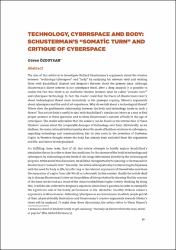| dc.contributor.author | Özdoyran, Güven | en_US |
| dc.date.accessioned | 2021-04-13T10:47:21Z | |
| dc.date.available | 2021-04-13T10:47:21Z | |
| dc.date.issued | 2018 | en_US |
| dc.identifier.citation | Özdoyran, G . (2019). TECHNOLOGY, CYBRRSPACE AND BODY: SCHUSTERMAN’S “SOMATİC TURN” AND CRITIQUE OF CYBERSPACE . İstanbul Arel Üniversitesi İletişim Çalışmaları Dergisi , 7 (14) , 12-33 . Retrieved from https://dergipark.org.tr/tr/pub/isauicder/issue/53168/705303 | en_US |
| dc.identifier.issn | 2146-4162 | |
| dc.identifier.uri | https://dergipark.org.tr/tr/pub/isauicder/issue/53168/705303 | |
| dc.identifier.uri | https://hdl.handle.net/20.500.12294/2701 | |
| dc.description.abstract | The aim of this article is to investigate Richard Shusterman’s arguments about the tension between “technology/cyberspace” and “body” by analyzing his relevant texts and relating them with Baudrillard, Husserl and Bergson’s theories about the present issue. Although Shusterman’s direct interest is not cyberspace itself, after a deep analysis it is possible to realize the fact that there is an inevitable relation between what he called “somatic turn”1 and cyberspace/technology. In fact, the reader could find the traces of Shusterman’s worry about technological threat most intensively in his passages arguing Gibson’s arguments about cyberspace and the end of art experience. Why do we talk about a technological threat? Where does the problematic relationship between the body and technology locate in such a threat? This article finds it useful to deal with Baudrillard’s simulation theory as a way to find proper answers to these questions and to show Shusterman’s concern of body in the age of cyberspace. The reader will realize that the answers can be found in the intersection of these thinkers’ unease about the irreparable damages of technology over body. Historically, as we shall see, the main rationale behind apathy about the mode of bodiless existence in cyberspace, regarding technology and communication, has its own roots in the invention of Cartesian Cogito in Western thought where the body has already been excluded from the arguments and life, and hence be marginalized. For fulfilling these tasks, first of all, this article attempts to briefly explain Baudrillard’s simulation theory in order to show the conditions for the absence of the body in technology and cyberspace, by elaborating on the levels of the image determined directly by the technological progress. At the end of this discussion, we will find the opportunity for passing to the reasons for Shusterman’s “somatic turn”. Secondly, the article will explain why Cartesian Cogito dispenses with the need for body in life, by referring to the relevant arguments of Husserl who mentions the separation of cogito from Life-World or Lebenswelt. In this context, thirdly the article shall try to discuss Shusterman’s view on the problem of interpretation by showing that his concern of the issue can be read as a result of the crisis resulted from Cogito-Centric thinking. By doing this, it will be also referred to Bergson’s argument about Zeno’s paradox in order to exemplify the significant role of the bodily performance in life. Hereafter, fourthly William Gibson’s arguments, in Neuromancer, defending cyberspace as an environment in which people get rid of their physical/bodily limitations and Shusterman’s counter-arguments towards Gibson’s views will be analyzed. To make clear these discussions, the article refers to Vilem Flusser’sarguments about the re-construction of reality through technology by arguing the ontological statuses of both “bodily existence” and “virtual existence”. Fifthly and finally, the article shall attempt to discuss Shusterman’s emphasize declaring that somatic turn necessitates also an aesthetic turn. In this part, we will see that Shusterman argues that technological progress is a threat for our relation with artworks by referring to Walter Benjamin’s well-known article “The Work of Art in the Age of Mechanical Reproduction”. | en_US |
| dc.language.iso | en | en_US |
| dc.publisher | İstanbul Arel Üniversitesi İletişim Fakültesi | en_US |
| dc.relation.ispartof | İstanbul Arel Üniversitesi İletişim Çalışmaları Dergisi | en_US |
| dc.rights | info:eu-repo/semantics/openAccess | en_US |
| dc.subject | Schusterman | en_US |
| dc.subject | Baudrillard | en_US |
| dc.subject | Body | en_US |
| dc.subject | New Media | en_US |
| dc.subject | Syberspace | en_US |
| dc.title | Technology, cybrrspace and body: Schusterman’s “somatic turn” and critique of cyberspace | en_US |
| dc.title.alternative | Teknoloji, siber-uzam ve beden: schusterman’ın “somatik dönüş”ü ve siber-uzam eleştirisi | en_US |
| dc.type | article | en_US |
| dc.department | İstanbul Arel Üniversitesi, İletişim Fakültesi, Yeni Medya ve İletişim Bölümü | en_US |
| dc.authorid | 0000-0002-8377-513X | en_US |
| dc.identifier.volume | 7 | en_US |
| dc.identifier.issue | 14 | en_US |
| dc.identifier.startpage | 12 | en_US |
| dc.identifier.endpage | 33 | en_US |
| dc.relation.publicationcategory | Makale - Ulusal - Editör Denetimli Dergi | en_US |
| dc.institutionauthor | Özdoyran, Güven | en_US |


















